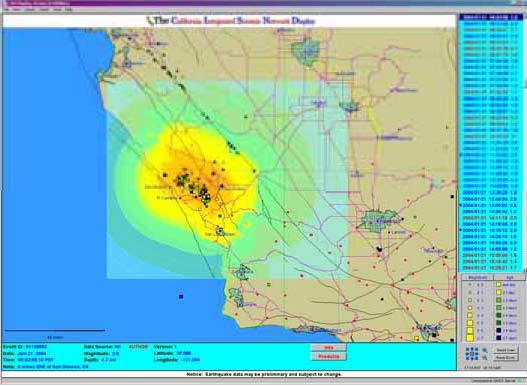Project Summary
The California Integrated Seismic Network (CISN) has collaborated to develop a next-generation earthquake notification system that is now operations-ready as of v1.0. The CISN Display will graphically alert users, in near real-time, of seismicity as well as vital earthquake-hazards information following a significant earthquake. This program suite is expected to provide emergency managers, and other decision makers with the information and tools necessary to effectively deploy limited personnel and resources in support of recovery efforts after a major earthquake. This effort helps fulfill a CISN mandate: to disseminate earthquake information in support of public safety, emergency response, and loss mitigation. This software architecture includes a client GUI known as the CISN Display, a server module identified as the QuakeWatch Server, and the messaging middleware supporting an XML messaging schema.

CISN Display with San Simeon M6.5 ShakeMap overlay.
Real-time Earthquake Display
Primary to the CISN Display’s operation is its active monitoring of near real-time seismicity, and other geo-hazards information. Newly received messages and updates are immediately posted to the screen. Virtually all user functionality previously available in CUBE/REDI has been replicated in the CISN Display. However, the new client also boasts a number of upgrades that enhance its functionality as well as its reliability and robustness. New improvements include stateful connectivity, fail-over capability, data persistence, platform independence, a highly configurable graphical-interface and modular software architecture. These design improvements combine to form the basis of a highly scalable client, and introduce a new level of reliability and application robustness not previously available.
Gateway to Other Earthquake Products
A secondary, but equally important function of the CISN Display is its service as a Web-portal to all relevant earthquake hazards information produced after a large earthquake. Web-based products currently available for delivery are ShakeMap, HAZUS Input files, Felt Reports, Focal Mechanisms, Waveform Images, Aftershock Forecasts, Tsunami Warnings and more. URLs to these and other Internet products are automatically created on the CISN Display and made available so users have quick access to crucial decision-making information In the case of ShakeMap, a behavior may be selected by the user to automatically display the ShakeMap in a separate browser window as soon as it becomes available on the Web. It is anticipated that the CISN Display distribution system will promote future online tools and services since they can be rapidly distributed and made available to critical users everywhere.
GIS Mapping Capabilities
To provide critical users a means of visually performing initial assessments of potentially damaged infrastructures, a GIS mapping engine has been integrated into the CISN Display. Thanks to the OpenMap project the client interface is able to plot many popular formats of GIS vector-layers. This allows users to make quick and reasonable assessments of vital infrastructure, when viewed alongside earthquake hazards information such as ShakeMap. In addition to geo-political boundaries as with state and county lines, imported GIS graphics may also represent roadways, airports, railroads, bridges and other public lifelines vulnerable to earthquake damage. In essences this mapping feature allows each organization to customize the application interface specific to their operation’s needs. Additionally, users can now have ShakeMap shapefiles automatically downloaded and plotted directly onto the CISN Display map. This added behavior was a direct result of beta-tester feedback, and illustrates the collaborative approach taken in user-participation development.
Additional Benefits
One of the many residual benefits to come from CISN Display’s development is its ability to extend its utility beyond California, as a nationwide geo-hazards alarming tool. Because of software design considerations made earlier on in its conception, this tool can easily scaled to include notifications outside the CISN region. Consequently, changes were made to facilitate other seismic networks to tailor the interface settings to their liking and allow them to operate the software as an integrated part of their operations.
Application Installation Requirements
Listed below are the recommended minimum items needed to operate the CISN Display application.
- ♦ Java Runtime Environment 1.4.X or higher (available from Sun at http://java.com/en/index.jsp)
Interested users will be asked to register their organization to gain access to the software. Users will create an account profile and provide basic contact information. Targeted users for the application are emergency management officials, and other critical operators. User requests will be approved based on the current ‘access policy’.
Development Partners
The CISN Display is being developed as part of the CISN, a cooperative project between Caltech, CGS, USGS, UCB and OES. Funding for the project comes from the OES, USGS, FEMA/OES Hazards Mitigation Grants Program, and other partners. For information regarding the CISN Display your local CISN representative, or contact Margaret Vinci, of Caltech, at 626 395-6318 or Hugo Rico, CISN Display project leader, at 626 395-2407.